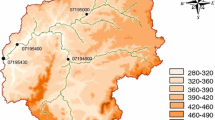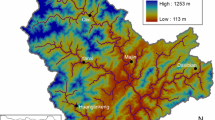Abstract
The physically based distributed hydrological models are ideal for hydrological simulations; however most of such models do not use the basic equations pertaining to mass, energy and momentum conservation, to represent the physics of the process. This is plausibly due to the lack of complete understanding of the hydrological process. The soil and water assessment tool (SWAT) is one such widely accepted semi-distributed, conceptual hydrological model used for water resources planning. However, the over-parameterization, difficulty in its calibration process and the uncertainty associated with predictions make its applications skeptical. This study considers assessing the predictive uncertainty associated with distributed hydrological models. The existing methods for uncertainty estimation demand high computational time and therefore make them challenging to apply on complex hydrological models. The proposed approach employs the concepts of generalized likelihood uncertainty estimation (GLUE) in an iterative procedure by starting with an assumed prior probability distribution of parameters, and by using mutual information (MI) index for sampling the behavioral parameter set. The distributions are conditioned on the observed information through successive cycles of simulations. During each cycle of simulation, MI is used in conjunction with Markov Chain Monte Carlo procedure to sample the parameter sets so as to increase the number of behavioral sets, which in turn helps reduce the number of cycles/simulations for the analysis. The method is demonstrated through a case study of SWAT model in Illinois River basin in the USA. A comparison of the proposed method with GLUE indicates that the computational requirement of uncertainty analysis is considerably reduced in the proposed approach. It is also noted that the model prediction band, derived using the proposed method, is more effective compared to that derived using the other methods considered in this study.






Similar content being viewed by others
References
Alazzy AA, Lü H, Zhu Y (2015) Assessing the uncertainty of the Xinanjiang rainfall-runoff model: effect of the likelihood function choice on the GLUE method. J Hydrol Eng 20(10). https://doi.org/10.1061/(ASCE)HE.1943-5584.0001174
Anand S, Mankin KR, McVay KA, Janssen KA, Barnes PL, Pierzynski GM (2007) Calibration and validation of ADAPT and SWAT for field-scale runoff prediction. J Am Water Resour Assoc 43(4):899–910
Arabi M, Govindaraju RS, Engel B, Hantush M (2007) Multiobjective sensitivity analysis of sediment and nitrogen processes with a watershed model. Water Resour Res 43(6):W06409. https://doi.org/10.1029/2006WR005463
Arnold JG, Fohrer N (2005) SWAT2000: current capabilities and research opportunities in applied watershed modeling. Hydrol Process 19(3):563–572
Arnold JG, Allen PM, Bernhardt G (1993) A comprehensive surface-ground water flow model. J Hydrol 142(1–4):47–69
Athira P, Sudheer KP (2015) A method to reduce the computational requirement while assessing uncertainty of complex hydrological models. Stoch Environ Res Rick Assess 29(3):847–859
Barlund I, Kirkkala T, Malve O, Kämäri J (2007) Assessing the SWAT model performance in the evaluation of management actions for the implementation of the water framework directive in a finnish catchment. Environ Model Softw 22(5):719–724
Beven KJ (2006) A manifesto for the equifinality thesis. J Hydrol 320:18–36
Beven KJ, Binley AM (1992) The future of distributed models: model calibration and uncertainty prediction. Hydrol Process 6:279–298. https://doi.org/10.1002/hyp.3360060305
Beven K, Binley A (2014) GLUE: 20 years on. Hydrol Process 28:5897–5918
Beven K, Freer J (2001) Equifinality, data assimilation, and uncertainty estimation in mechanistic modelling of complex environmental systems using the glue methodology. J Hydrol 249(14):11–29
Blazkova S, Beven K (2009) A limits of acceptability approach to model evaluation and uncertainty estimation in flood frequency estimation by continuous simulation: Skalka catchment, Czech Republic. Water Resour Res 45:W00B16. https://doi.org/10.1029/2007wr006726
Carota C, Parmigiani G, Polson NG (1996) Diagnostic measures for model criticism. J Am Stat Assoc 91:753–762
Christensen S (2004) A synthetic groundwater modeling study of the accuracy of GLUE uncertainty intervals. Nord Hydrol 35(1):45–59
Cibin R, Sudheer KP, Chaubey I (2010) Sensitivity and identifiability of stream flow generation parameters of the SWAT model. Hydrol Processes 24(9):1133–1148
Cibin R, Athira P, Sudheer KP, Chaubey I (2014) Application of distributed hydrological models for predictions in ungauged basins: A method to quantify predictive uncertainty. Hydrol Proces. https://doi.org/10.1002/hyp.9721
Confessor RB Jr, Whittaker GW (2007) Automatic calibration of hydrologic models with multi-objective evolutionary algorithm and pareto optimization. J Am Water Resour Assoc 43(4):981–989
Demaria EM, Njissen B, Wagener T (2007) Monte Carlo sensitivity analysis of land surface parameters using the variable iniltration capacity model. J Geophys Res 112:D11113
Freer J, Beven KJ, Ambroise B (1996) Bayesian estimation of uncertainty in runoff prediction and the value of data: an application of the GLUE approach. Water Resour Res 32(7):2161–2173
Freni G, Mannina G (2010) Bayesian approach for uncertainty quantification in water quality modeling: the influence of prior distribution. J Hydrol 392:31–39
Gardner RH, O’Neill RV (1983) Parameter uncertainty and model predictions: a review of Monte Carlo results. In: Berk MB, Straten GV (eds) Uncertainty and forecasting of water quality. Springer, New York, pp 245–257
Gassman PW, Reyes MR, Geen CH, Arnold JG (2007) The soil and water assessment assessment tool: historical development, applications and future research directions. Trans ASABE 50(4):1211–1250
Haan CT (2002) Statistical methods in hydrology. Iowa State Press, Ames
Jeremiah E, Sisson SA, Sharma A, Marshall L (2012) Efficient hydrological model parameter optimization with Sequential Monte Carlo Sampling. Environ Model Softw 38:283–295
Jin X, Chong-Yu Xu, Zhang Q, Singh VP (2010) Parameter and modeling uncertainty simulated by GLUE and a formal Bayesian method for a conceptual hydrological model. J Hydrol 383:147–155
Katz RW (2002) Techniques for estimating uncertainty in climate change scenarios and impact studies. Clim Res 20:167–185
Kuczera G, Parent E (1998) Monte Carlo assessment of parameter uncertainty catchment models: the Metropolis algorithm. J Hydrol 211:69–85
Li H, Wu J (2006) Uncertainty analysis in ecological studies. In: Wu J, Jones KB, Li H, Loucks OL (eds) Scaling and uncertainty analysis in ecology:methods and applications. Springer, Netherlands
Li L, Xia J, Xu CY, Singh VP (2010) Evaluation of the subjective factors of the GLUE method and comparison with the formal Bayesian method in uncertainty assessment of hydrological models. J Hydrol 390(3–4):210–221
MacKay DJC (2003) Information theory, inference and learning algorithms. Cambridge University Press, Cambridge. ISBN 0-521-64298-1
Manache G, Melching CS (2008) Identification of reliable regression- and correlation-based sensitivity measures for importance ranking of water-quality model parameters. Environ Model Softw 23:549–562
Mantovan P, Todini E (2006) Hydrological forecasting uncertainty assessment: incoherence of the GLUE methodology. J Hydrol 330:368–381. https://doi.org/10.1016/j.jhydrol.2006.04.046
May RJ, Dandy GC, Maier HR, Nixon JB (2008) Application of partial mutual information variable selection to ANN forecasting of water quality in water distribution systems. Environ Model Softw 23(10–11):1289–1299
McMillan H, Clark M (2009) Rainfall-runoff model calibration using informal likelihood measures within a Markov chain Monte Carlo sampling scheme. Water Resour Res 45:W04418. https://doi.org/10.1029/2008WR007288
Migliaccio KW, Chaubey I (2008) Spatial distributions and stochastic parameter influences on SWAT flow and sediment predictions. J Hydrol Eng 13(4):258–269
Mirzaei M, Huang YF, El-Shafie A, Shatirah A (2015) Application of the generalized likelihood uncertainty estimation (GLUE) approach for assessing uncertainty in hydrological models: a review. Stoch Environ Res Risk Assess 29:1265–1273
Montanari A (2005) Large sample behaviors of the generalized likelihood uncertainty estimation (GLUE) in assessing the uncertainty of rainfall-runoff simulations. Water Resour Res 41:W08406. https://doi.org/10.1029/2004WR003826
Mukund Nilakantan J, Ponnambalam SG et al (2015) Bio-inspired search rithms to solve robotic assembly line balancing problems. Neural Comput Appl 26(6):1379–1393
Neitsch SL, Arnold JG, Kiniry JR, Williams JR, King KW (2002) Soil water assessment tool theoretical documentation version 2000. Texas Water Resource Institute, College Station (TWRI Report, TR-191)
Nott DJ, Marshall L, Brown J (2012) Generalized likelihood uncertainty estimation (GLUE) and approximate Bayesian computation: what’s the connection? Water Resour Res 48:W12602. https://doi.org/10.1029/2011WR011128
Rastetter EB, King AW, Cosby BJ, Hornberger GM, O’Neill RV, Hobbie JE (1992) Aggregating fine-scale ecological knowledge to model coarser-scale attributes of ecosystems. Ecol Appl 2:55–70
Refsgaard JC, Sluijs JP, Hojberg AL, Vanrolleghem PA (2007) Uncertainty in the environmental modeling process—a framework and guidance. Environ Model Softw 22:1543–1556
Sadegh M, Vrugt JA (2013) Bridging the gap between GLUE and formal statistical approaches: approximate Bayesian computation. Hydrol Earth Syst Sci 17:4831–4850
Schoups G, Vrugt JA (2010) A formal likelihood function for parameter and predictive inference of hydrologic models with correlated, heteroscedastic, and non-Gaussian errors. Water Resour Res 46:W10531. https://doi.org/10.1029/2009WR008933
Smith PJ, Beven K, Tawn JA (2008) Informal likelihood measures in model assessment: theoretic development and investigation. Adv Water Resour Res 31:1087–1100
Stedinger JR, Vogel RM, Lee SU, Batchelder R (2008) Appraisal of the generalized likelihood uncertainty estimation (GLUE) method. Water Resour Res. https://doi.org/10.1029/2008wr006822
Steuer R, Kurths J, Daub CO, Weise J, Selbiq J (2002) The mutual information: detecting and evaluating dependencies between variables. Bioinformatics 18:S231–S240
Talebizadeh M, Morid S, Ayyoubzadeh SA, Ghasemzadeh M (2010) Uncertainty analysis in sediment load modeling using ANN and SWAT model. Water Resour Manag 24:1747–1761. https://doi.org/10.1007/s11269-009-9522-2
Uniyal B, Jha MK, Verma AK (2015) Parameter identification and uncertainty analysis for simulating streamflow in a river basin of Eastern India. Hydrol Process 29:3744–3766
Vrugt JA, Gupta HV, Bouten W, Sorooshian S (2003) A shuffled complex evolution metropolis algorithm for optimization and uncertainty assessment of hydrologic model parameters. Water Resour Res 39(8):1201. https://doi.org/10.1029/2002wr001642
Vrugt JA, Braak CJF, Clark M, Hyman JM, Robinson BA (2008a) Treatment of input uncertainty in hydrologic modeling: doing hydrology backward with Markov chain Monte Carlo simulation. Water Resour Res 44:W00B09. https://doi.org/10.1029/2007wr006720
Vrugt JA, Braak CJF, Gupta HV, Robinson BA (2008b) Equifinality of formal (DREAM) and informal (GLUE) Bayesian approaches in hydrologic modeling? Stoch Environ Res Risk Assess 23:1011–1026. https://doi.org/10.1007/s00477-008-0274-y
Warmink JJ, Janssen JAEB, Booij MJ, Krol MS (2010) Identification and classification of uncertainties in the application of environmental models. Environ Model Softw 25:1518–1527
West M (1993) Approximating posterior distributions by mixture. J R Stat Soc B 55(2):409–422
Wiwatenadate P, Claycamp HG (2000) Error propagation of uncertainties in multiplicative models. Hum Ecol Risk Assess 6:355–368
Wu Y, Liu S (2012) Automating calibration, sensitivity and uncertainty analysis of complex models using the R package flexible modeling environment (FME): SWAT as an example. Environ Model Softw 31:99–109
Xiong LH, Wan M, Wei XJ, O’Connor KM (2009) Indices for assessing the prediction bounds of hydrological models and application by generalised likelihood uncertainty estimation. Hydrol Sci J-Journal Des Sciences Hydrologiques 54(5):852–871
Yen H, Jeong J, Feng QY, Deb D (2015) Assessment of input uncertainty in SWAT using latent variables. Water Resour Manag 29:1137–1153
Zhang Z (2012) Iterative posterior inference for Bayesian Kriging. Stoch Environ Res Rick Assess 26(7):913–923
Zhang W, Li T (2015) The influence of objective function and acceptability threshold on uncertainty assessment of an urban drainage hydraulic model with generalized likelihood uncertainty estimation methodology. Water Resour Manag 29:2059–2072
Zhang X, Srinivasan R, Liew MV (2008) Multi-site calibration of the SWAT model for hydrologic modeling. Trans ASABE 51(6):2039–2049
Zhang Y, Xia J, Shao X (2011) Water quantity and quality simulation by improved SWAT in highly regulated Huai river basin of China. Stoch Environ Res Risk Assess. https://doi.org/10.1007/s00477-011-0546-9
Zhang J, Li Q, Guo B, Gong H (2015) The comparative study of multi-site uncertainty evaluation method based on SWAT model. Hydrol Process 29:2994–3009
Zhenyao S, Lei C, Tao C (2012) The influence of parameter distribution uncertainty on hydrological and sediment modeling: a case study of SWAT model applied to the Daning watershed of the three Gorges Reservoir Region China. Stoch Env Res Risk Assess. https://doi.org/10.1007/s00477-012-0579-8
Author information
Authors and Affiliations
Corresponding author
Rights and permissions
About this article
Cite this article
Athira, P., Nanda, C. & Sudheer, K.P. A computationally efficient method for uncertainty analysis of SWAT model simulations. Stoch Environ Res Risk Assess 32, 1479–1492 (2018). https://doi.org/10.1007/s00477-018-1538-9
Published:
Issue Date:
DOI: https://doi.org/10.1007/s00477-018-1538-9




